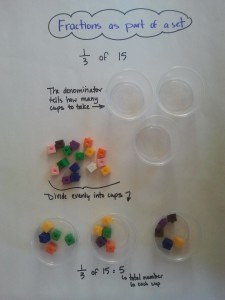Fractions as a part of a set

Fractions as a part of a set can be tricky for students. Especially when we spend a lot of time teaching fractions as a part of a whole (1 of the 6 equal pieces of pie) and the area model of fractions (1 of the 6 equal regions of the rectangle).
When it comes to fractions as a part of a set, I start easy by asking students to count the number of people in class. If there is an odd number of students, I include myself so that they end up with an even number. Next, I ask them how many people would end up in each group if we divided the group in half…and then we do it. This gives them a visual of two groups with x number of people in each group.
We then break into small groups and students discuss how it is possible for 14 students to represent the fraction 1/2 (in this example, 14 is half of the 28 people in class.) This is a great way for them to see that the 14 people are a part of the entire set of people which we are dividing into two equal parts. Therefore, the 14 students represent one of the two equal parts which make up the group.
Next, we work on examples like the one in the above photo.